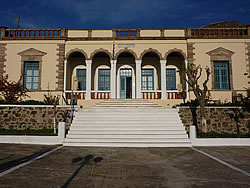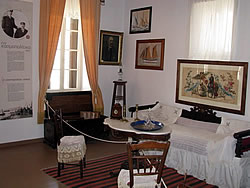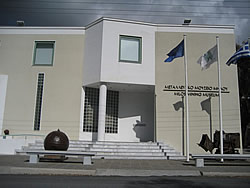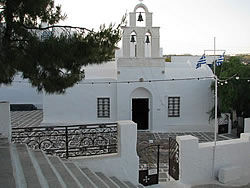 Archaeological Museum (Plaka)
Archaeological Museum (Plaka)
The Archaeological Museum of Milos is located in Plaka, housed in a beautiful neoclassical building of Ernst Ziller. In the museum you can see the following collections:
• Prehistoric collection from Phylakopi
• Collection of sculptures and reliefs
• Collection of obsidian
• Collection of inscriptions
At the entrance of the Museum (Hall A) the replica of Venus of Milos dominates, built by the laboratory of the Louvre. On the left side of the room you can see displays with blades, flakes and obsidian flakes from Phylakopi, the Nails and the Demenegaki. Also in the same room you have the opportunity of seeing a 6th century BC grave.
Moving on to the left room (Hall B), you can see the prehistoric objects, from the 5th millennium until the end of the 2nd millennium BC. There you will find displays of finds from excavations of the ancient Phylakopi, many vases painted with lily’s, figurines, poros altar from the sanctuary of Phylakopi, a small collection of Cycladic marble figurines and the famous "Lady of Phylakopi".
In the small hall behind the entrance (Hall C), you will find geometric projects, archaic, classical, Hellenistic and Roman, several coins, tools and objects.
Finally, moving to the right of the entrance hall (Hall D), you will see finds from the ancient city of Klima, several sculptures from the Hellenistic and Roman period (ballast statue by Marios Trofimos, funerary relief of a young man with his servant, etc.), votive and marble slabs with the archaic alphabet of Milos (Due to the peak Milos had reached in the historical period, they had developed their own “Milos alphabet”, which consisted of 21 letters).
|
|
 Folklore Museum (Plaka)
Folklore Museum (Plaka)
Behind the church of Panagia Korfiatissa in Plaka, you will find the Museum of History & Folklore. The museum was founded in 1967 by the "Association of Milos in Athens" and in it, you have the opportunity of learning more about the life of the people of Milos after the 17th century (mostly from 1850 to 1930, which was a period of prosperity for the society Milos).
With your visit to this museum, you will travel to another era, because you will see how an urban household in Milos was in the 19th century. The museum is not an accurate representation of the households, but from often heterogeneous objects, aspects of the residents lives in that era are illuminated: their occupations within and outside the home, influences from other places, food and clothing preferences, the way they entertained themselves, the organization of space and time and the use of local resources.
This two-story museum consists the living room and exhibits that are unique, a workplace where the loom is, the kitchen of the house, the bedroom, the pantry (which served as a repository of agricultural products), and the gallery, which is a historical archive. In all these rooms you can also admire furniture, embroideries, costumes of that era, utensils for the home, decorations and everyday objects and old photographs.
|
 Mining Museum (Neochori)
Mining Museum (Neochori)
The Mining Museum of Milos, is an urban, non-profit corporation, created by S & B Industrial Minerals SA in 1998 to honor and promote the mining history and the geological and natural heritage of the island.
In the entrance hall it shows the social, economic and technological dimensions of the mining history and tradition of the island. The exhibition of the first floor is dedicated to the natural and geological wealth of the island, showing the minerals mined in the island since the Neolithic Age to the present industrial minerals, with particular emphasis on their uses in everyday life. Additionally, movies are shown on the extraction and production of the minerals, while in the projection room, visitors "travel" in earlier times through the narratives of former miners.
|
 Ecclesiastical (Church) Museum (Adamas)
Ecclesiastical (Church) Museum (Adamas)
Very close to the harbour of Adamas, is the church of St. Trinity, which also hosts the Church Museum. This church, which counts one thousand years of life, is characterized as "cross-shaped triple royal with an arched dome" and consists of three aisles over which the dome rises vertically in the same shape as the temple. This kind of church is found very rarely (there is only one other church in the Peloponnese, in Arcadia Levidi) and is a very interesting architectural monument.
Originally created to serve as a monastery by the name of Panagia of Theophanes, in 1839 the Cretan refugees bought it and made it the church of their village. The edges and arcs of the bell are influenced by the Gothic, and the lintels and jambs are decorated with traditional sculptures and religious motifs. Entering the courtyard, you'll see two mosaic creations of a local artist, Yiangos Kavroudakis. These two colourful mosaics are dated back to 1937 and one represents a dragon in the shape of the island, while the other shows the battle between good and evil.
Since 2000, the Church Museum of Milos is housed in St. Trinity, where you have the opportunity to admire much of the artistic tradition, the heritage and the hagiographic tradition of the island. More specifically, you can view images from the 14th century (as a rare deposition), the Cretan projects, works of Emmanuel and Anthony Skordilis and of the Cretan painters, epitaphs and wooden desks, shrines of the 17th century, the Episcopal throne, their temples, silver chalices, censers, votive gold, rings, necklaces, earrings and other exhibits of high artistic value.
|
|


